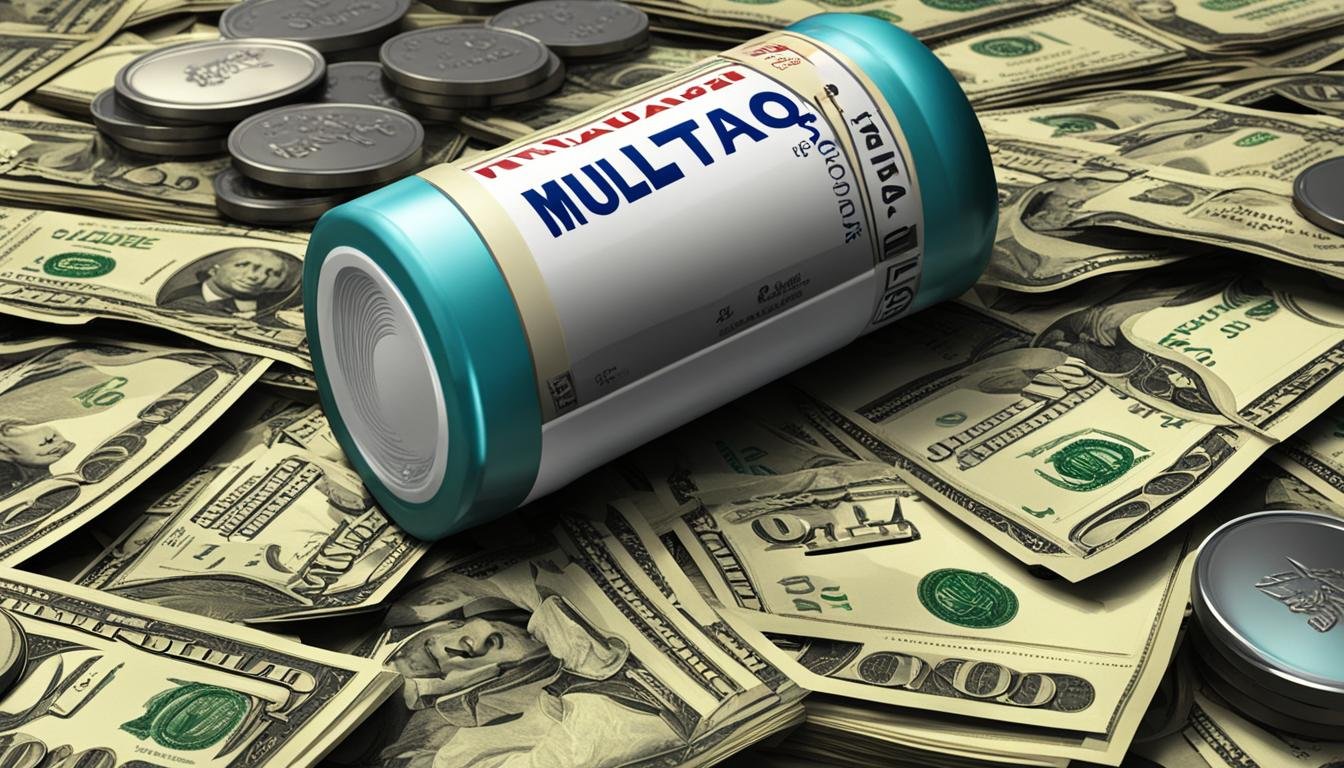Are you wondering why Multaq, a medication used to reduce the risk of hospitalization in individuals with atrial fibrillation, comes with such a high price tag? Understanding the reasons behind the expensive cost of Multaq can help shed light on this issue.
One of the main factors contributing to the high cost of Multaq is the absence of generic versions. Unlike many other prescription drugs, Multaq does not have cheaper alternatives available in the form of generic medications. This lack of competition allows the brand-name drug to maintain its higher price point.
Without insurance, Multaq can cost an average of $884 for a 30-day supply, making it a considerable financial burden for many individuals. A full year of treatment with Multaq can exceed $10,000, further adding to the overall expenses.
However, there are options available to make Multaq more affordable for those in need. Using a discount card or enrolling in patient assistance programs, such as Sanofi-Aventis’ Patient Connection, can provide financial relief and help mitigate the high cost of Multaq.
Key Takeaways:
- Multaq’s high cost is mainly due to the absence of generic versions.
- Without insurance, Multaq can cost an average of $884 for a 30-day supply.
- Enrolling in patient assistance programs or using discount cards can help make Multaq more affordable.
- Multaq is a brand-name prescription drug used to reduce the risk of hospitalization in individuals with atrial fibrillation.
- Understanding the factors affecting Multaq’s high cost can help individuals find financial solutions.
Insurance Coverage for Multaq
When considering the cost of Multaq, it is important to understand the insurance coverage options available. Most commercial health insurance plans, Medicare Part D, and Medicaid typically cover Multaq prescriptions, which can help alleviate some of the financial burden. However, it’s crucial to note that the out-of-pocket costs can still vary depending on several factors.
One key factor to consider is the formulary tier that Multaq falls under in a specific insurance plan. Formularies categorize medications into different tiers, with Tier 1 typically being the lowest-cost option and Tier 4 being the highest-cost option. Multaq is often assigned as Tier 2 or Tier 3, which can result in higher copay costs for individuals.
To get a clearer understanding of the specific coverage and potential copay costs, it is recommended to contact the insurance provider or review the plan’s drug formulary. By doing so, individuals can better assess the financial implications of using Multaq and explore alternative options if necessary.
Alternatives and Cost-Saving Measures for Multaq
If the cost of Multaq is a concern, there are alternatives and cost-saving measures that can be explored. Healthcare professionals may suggest alternative heart rhythm drugs that could be as effective in preventing hospitalization for atrial fibrillation. These alternative medications, also known as dronedarone alternatives, may offer a lower-cost option for patients.
Additionally, there are several strategies to help reduce the cost of Multaq medication. One option is to utilize a Multaq coupon, which can provide discounts on prescription refills. Patients can also consider enrolling in patient assistance programs, such as the Multaq Patient Assistance Program offered by Sanofi-Aventis, to receive financial support for their medication expenses. These programs are designed to provide assistance to eligible individuals who are unable to afford their prescribed medications.
An alternative solution to consider is the SingleCare discount card. By using this card, patients can save up to $150 per month on their Multaq prescription. This can significantly reduce the out-of-pocket cost, making Multaq more affordable for those who may not have insurance coverage or are facing high copay costs.
Comparison with Generic Amiodarone
When considering the cost of Multaq, it is important to compare its effectiveness and side effects with those of its generic alternative, amiodarone. A study conducted by Cedars-Sinai Medical Center found that while Multaq, containing dronedarone, can reduce the risk of hospitalization for atrial fibrillation, it is only half as effective as generic amiodarone in achieving the same outcome.
Furthermore, the study revealed that there is no significant difference in the side effects between Multaq and amiodarone. This means that despite the higher cost of Multaq, patients may experience similar side effects with either medication.
In terms of cost comparison, amiodarone is significantly cheaper than Multaq. This makes it a more cost-effective alternative for individuals looking to manage their medication expenses.
Key Points:
- Multaq, containing dronedarone, is only half as effective as generic amiodarone in reducing the risk of hospitalization for atrial fibrillation.
- There is no significant difference in side effects between Multaq and amiodarone.
- Amiodarone is significantly cheaper than Multaq, making it a more cost-effective alternative.

By considering the effectiveness, side effects, and cost of Multaq compared to generic amiodarone, individuals can make informed decisions about their treatment options. It is important to consult healthcare professionals to determine the most suitable medication based on individual circumstances and financial considerations.
Conclusion
In conclusion, the high cost of Multaq can be a significant financial burden for individuals without insurance or facing high copay costs. However, there are various options available to help manage and reduce Multaq expenses.
One approach is to explore discount cards and patient assistance programs, such as Sanofi-Aventis’ Patient Connection. These resources can provide financial relief and make Multaq more affordable for those in need.
Another strategy is to consider alternative medications that may be equally effective in reducing the risk of hospitalization for atrial fibrillation. Consulting with healthcare professionals can help individuals assess the cost-effectiveness of Multaq compared to other options, such as generic amiodarone.
Ultimately, by carefully evaluating individual circumstances and utilizing available resources, individuals can find financial solutions and affordable alternatives to manage Multaq expenses. It is crucial to prioritize one’s health while also being mindful of the financial implications and seeking the most suitable options.
FAQ
Why is Multaq so expensive?
Multaq’s high cost is primarily due to the lack of cheaper generic versions currently available on the market. The absence of generic competition keeps the price of Multaq elevated.
How much does Multaq cost without insurance?
Without insurance, Multaq can cost an average of $884 for a 30-day supply, and a year of treatment can exceed $10,000.
Does insurance cover Multaq?
Most commercial health insurance plans, Medicare Part D, and Medicaid typically cover Multaq prescriptions. However, the out-of-pocket cost can vary depending on the insurance plan’s formulary, deductible, coinsurance, and any coverage gaps.
What can I do to make Multaq more affordable?
There are several options to make Multaq more affordable. You can use a discount card like SingleCare, which can reduce the cost of Multaq by up to $150 per month. Enrolling in patient assistance programs like Sanofi-Aventis’ Patient Connection may also provide financial relief for Multaq expenses. Additionally, healthcare professionals can suggest alternative heart rhythm drugs that may be as effective in preventing hospitalization for atrial fibrillation.
How does Multaq compare to generic amiodarone?
A study conducted by Cedars-Sinai Medical Center found that generic amiodarone is only half as effective as Multaq in reducing the risk of hospitalization for atrial fibrillation. There is no significant difference in side effects between the two medications. Considering the lower cost and comparable efficacy, generic amiodarone may be a more cost-effective alternative to Multaq.

